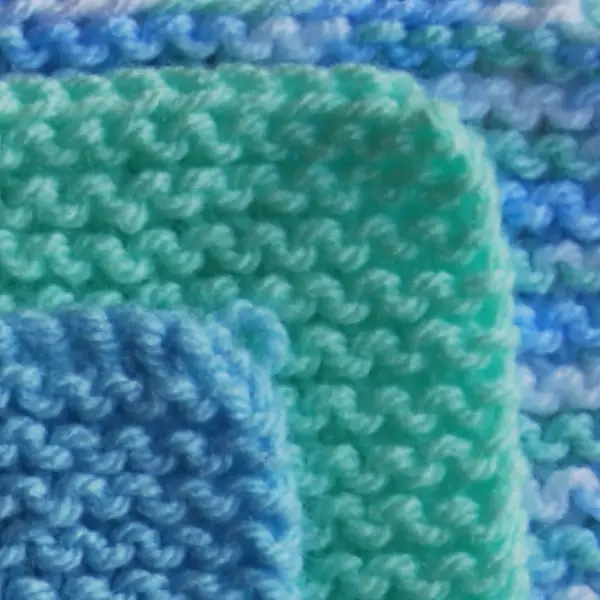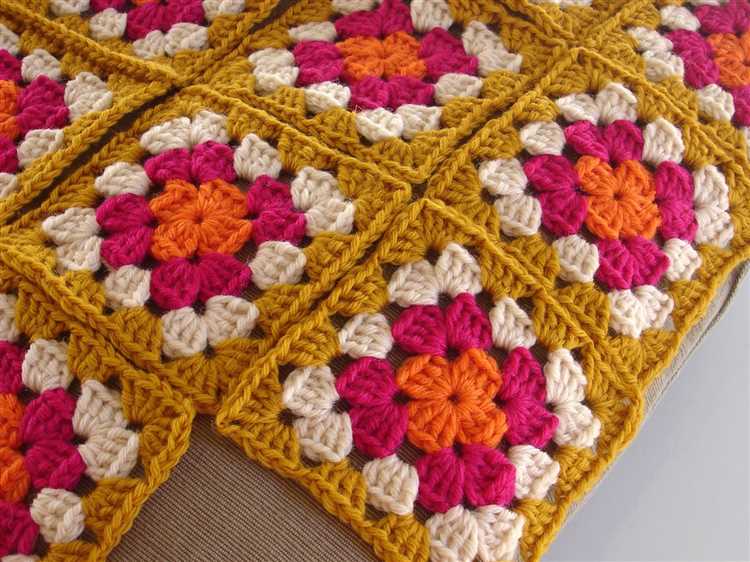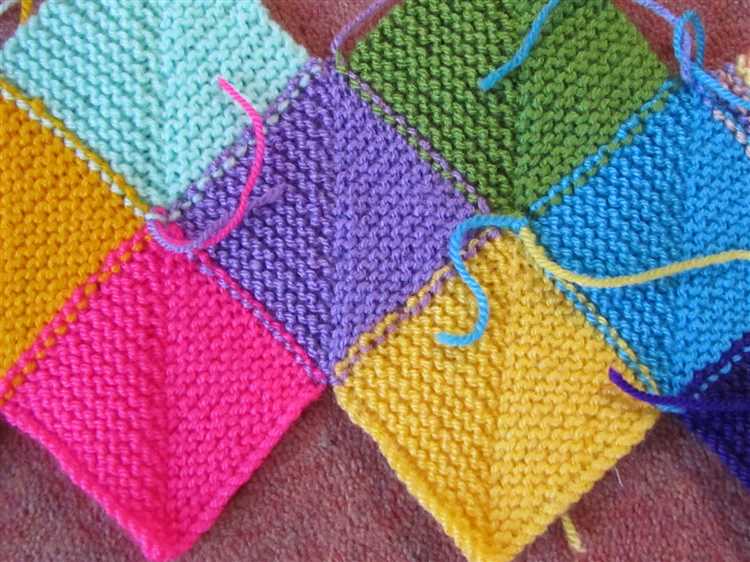Knitting is a popular craft that allows you to create beautiful and cozy items, such as blankets and scarves. One technique that knitters often use is to knit individual squares and then join them together to create a larger piece. This step-by-step guide will walk you through the process of joining knitted squares, so you can create your own stunning creations.
Before you begin joining your squares, it is important to have all of your squares knit and blocked to the same size. Blocking helps to ensure that your squares are even and will make the joining process much easier. Once your squares are ready, gather your materials, including a darning needle, scissors, and matching yarn.
The first method we will explore is the mattress stitch. This method creates an invisible seam that is perfect for joining squares with smooth edges. To begin, line up two squares side by side with the right sides facing up. Thread your darning needle with the matching yarn, and starting at the bottom-right corner of the left square, insert the needle under the first horizontal bar between the stitches. Then, bring the needle through the corresponding bar on the right square.
Continue to work your way up the squares, alternating between sides and inserting the needle under the corresponding bars. Take care to keep your tension even and be consistent with your stitches. When you reach the top of the squares, secure the yarn and weave in any loose ends. Your squares will now be joined together seamlessly.
If you prefer a more visible seam, you can use the whipstitch method. This method is great for joining squares with decorative edges or when you want to add a contrasting color to your seam. To begin, position your squares with the right sides facing each other. Thread your darning needle with the matching yarn, and starting at the bottom-right corner, insert the needle through both layers of fabric. Bring the needle back up through the fabric a short distance away, and then insert it back into both layers of fabric. Continue stitching in this manner, working your way up the squares until they are fully joined.
With these step-by-step instructions, you’ll now be able to confidently join your knitted squares and create stunning finished projects. Whether you choose the invisible seam of the mattress stitch or the visible seam of the whipstitch, your knitted squares will come together beautifully, adding warmth and style to your home.
Getting Familiar with Knitted Squares
Knitted squares are a popular and versatile project for knitters of all levels. They can be used to create a variety of items, such as blankets, scarves, and even clothing. Understanding the basics of knitted squares is the first step in joining them together to create a larger project.
Materials Needed:
- Yarn in desired color(s)
- Knitting needles
- Tapestry needle
- Scissors
Step 1: Cast On
Start by casting on the desired number of stitches for your knitted square. This will vary depending on your project and personal preference. The most common method is the long-tail cast on, but you can use any cast on method you prefer.
Step 2: Knit the Rows
Once you have cast on, you will begin knitting the rows of your knitted square. This can be done using the basic knit stitch or any other stitch pattern you prefer. Continue knitting until your square reaches the desired length.
Step 3: Bind Off
When your square is the desired length, it’s time to bind off. This will create a neat edge and secure your stitches. Again, there are various bind off methods you can use, so choose the one that best suits your project.
Step 4: Repeat
Repeat steps 1-3 to create additional knitted squares. You can use the same color or mix and match different colors to create a unique pattern.
Step 5: Joining the Squares
Once you have created multiple knitted squares, you can start joining them together. There are several methods for joining squares, including mattress stitch, whipstitch, and crochet slip stitch. Choose the method that works best for your project and desired outcome.
Step 6: Finishing Touches
After joining the squares, you may want to add any finishing touches, such as blocking or adding a border. This will help give your project a polished and professional look.
With these basic steps, you can easily create and join knitted squares to make beautiful and functional items. Have fun experimenting with different stitch patterns and colors to create unique designs!
Gathering Supplies for Joining Squares
Before you start joining your knitted squares together, it’s important to gather all the necessary supplies. Here is a list of items you will need:
- Knitted squares: Have all your knitted squares ready to be joined. Make sure they are blocked if necessary.
- Yarn: Choose a yarn that matches the color or compliments the squares. Make sure you have enough yarn to join all the squares.
- Tapestry needle: Use a tapestry needle with a large eye that will easily accommodate the yarn and help you sew the squares together.
- Scissors: Keep a pair of scissors handy to cut the yarn when needed.
- Blocking tools (optional): If your squares require blocking, you may also need blocking pins and a blocking mat.
In addition to these supplies, it’s important to have a clean and well-lit workspace to ensure accuracy while joining the squares. Organize your supplies and set aside some time to complete the joining process without interruptions.
Preparing the Squares for Joining
Before you begin joining your knitted squares, it is important to make sure they are properly prepared. This will help ensure a neat and professional finish to your project. Here are the steps to follow:
- Block the squares (optional): If your squares are not already blocked, you may want to consider blocking them before joining. Blocking helps even out the stitches and ensures that each square is the same size. To block your squares, wet them in cool water, gently squeeze out the excess water, and then lay them flat on a towel to dry, reshaping them as necessary.
- Weave in loose ends: If you have loose yarn ends from changing colors or joining new yarn, now is the time to weave them in. Use a tapestry needle to carefully weave the ends into the back of the knitted fabric, making sure to secure them well.
- Plan the layout: Take some time to plan the layout of your squares before starting the joining process. Arrange them in the desired pattern and make any adjustments necessary to get the look you want. This will give you a clear idea of how the finished project will look and help you avoid any mistakes during the joining process.
By preparing your squares properly before joining, you can ensure a successful and enjoyable knitting experience.
Choosing a Joining Method
When it comes to joining knitted squares, there are several methods to choose from. This decision will largely depend on the look you want to achieve and your knitting skill level. Here are some popular joining methods:
- Whipstitch: This is the most basic joining method and is great for beginners. Using a yarn needle, simply stitch through the edges of the squares in a whipstitch pattern.
- Mattress Stitch: This method creates an invisible seam and is commonly used for joining sweater seams. It involves using a tapestry needle to weave the yarn in and out of the edges of the squares.
- Crochet Slip Stitch: If you’re comfortable with crochet, this method can offer a neat and decorative join. Simply insert the crochet hook through both edges of the squares and slip stitch across.
- Three-Needle Bind Off: This joining method not only connects the squares but also creates a decorative ridge. It requires an extra knitting needle and involves knitting the stitches from two squares together.
- Join-As-You-Go: This method allows you to join the squares as you knit them, eliminating the need for any additional finishing work. It can be done by knitting or crocheting the squares together as you go along.
Choosing the right joining method is a matter of personal preference and the desired look for your knitted project. Whether you prefer a seamless finish or a decorative join, there is a method that will work best for you. Take the time to experiment and find the technique that suits your style and skill level.
Joining the Knitted Squares
After you have finished knitting your squares, it’s time to join them together to create your desired project. There are several ways to join knitted squares, but here is a step-by-step guide on one common method:
- Lay out your squares: Start by laying out your knitted squares in the desired pattern or arrangement. This will help you plan the joining process and make sure everything fits together correctly.
- Select a joining method: Decide on the joining method you want to use. Some common methods include using a whipstitch, mattress stitch, or crochet slip stitch. Choose the method that best suits your project and personal preference.
- Gather your materials: Depending on the joining method you’ve chosen, you may need a yarn needle, crochet hook, or sewing needle and thread. Make sure you have the necessary materials readily available.
- Start joining: Begin joining the squares together using your selected method. Take your time and work carefully to ensure the squares are joined securely and evenly. Follow the specific instructions for your chosen joining method.
- Secure loose ends: Once all the squares are joined together, weave in any loose ends of yarn to ensure a neat and finished appearance. This can be done using a yarn needle or crochet hook, depending on the thickness of the yarn.
- Block and finish: Finally, block your finished project to even out the tension and give it a polished look. You can use steam or water blocking techniques, depending on the fiber content of your squares. Once dry, your joined knitted squares are ready to be used!
Remember, joining knitted squares requires patience and attention to detail. Take your time and enjoy the process, and soon you’ll have a beautiful finished project made from your knitted squares!
Finishing Touches on the Joined Squares
Once you have successfully joined your knitted squares together, there are a few finishing touches you can add to give your project a polished look.
Weaving in Ends:
Start by weaving in any loose ends of yarn from where you attached the squares. You can use a yarn needle to neatly thread the ends back into the knitted fabric. Trim any excess yarn to ensure a clean finish.
Blocking:
Blocking your joined squares can help smooth out any uneven edges and give your project a more professional appearance. To block, wet your project gently, then lay it flat on a clean towel. Use pins or blocking wires to shape the squares into the desired dimensions and allow them to dry completely.
Adding Border or Edging:
If you want to give your joined squares a decorative border or edging, you can pick up stitches along the outer edges of your project. Choose a contrasting color or texture of yarn to create a visually appealing border. Experiment with different stitch patterns to add interest.
Seaming:
If you prefer a seamless look, you can use a technique called “mattress stitch” to seam the squares together. This involves using a yarn needle to stitch the edges of the squares together, creating an invisible seam. Make sure to line up the stitches and work from the back of the fabric to achieve a neat result.
Blocking and Caring for the Finished Project:
After applying any finishing touches, it’s essential to block your project once again to help it retain its shape. Follow the same blocking process you used for the squares. Additionally, check the care instructions for the type of yarn you used and wash your project accordingly to keep it looking its best.
By following these finishing steps, you can elevate your joined knitted squares to a professional-looking finished project that you can be proud of. Experiment with different techniques and embellishments to make your project unique!
FAQ:
What materials do I need to join knitted squares?
To join knitted squares, you will need a tapestry needle and a length of yarn in the same color as your squares.
What is the best method to join knitted squares?
There are several methods for joining knitted squares, but the most common and simplest method is the mattress stitch. This method creates an invisible seam and gives a professional finish to your project.
Can I join knitted squares using a sewing machine?
No, it is not recommended to join knitted squares using a sewing machine. The delicate nature of knitted fabric can be easily damaged by the machine’s needle and could ruin your project. It is best to join knitted squares by hand using a tapestry needle and yarn.
Is it possible to join knitted squares without using a needle?
Yes, it is possible to join knitted squares without using a needle. One alternative method is the slip stitch crochet method, which involves using a crochet hook and slip stitching the squares together. This method creates a decorative border between the squares and can give a different look to your finished project.


